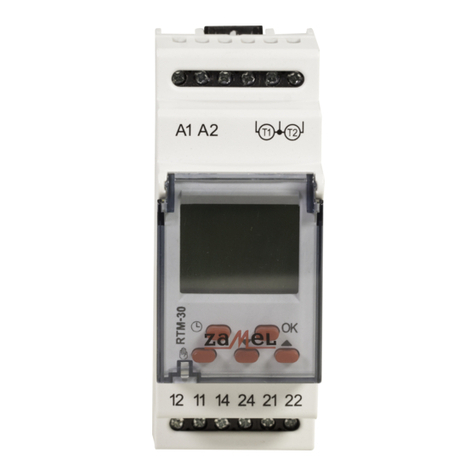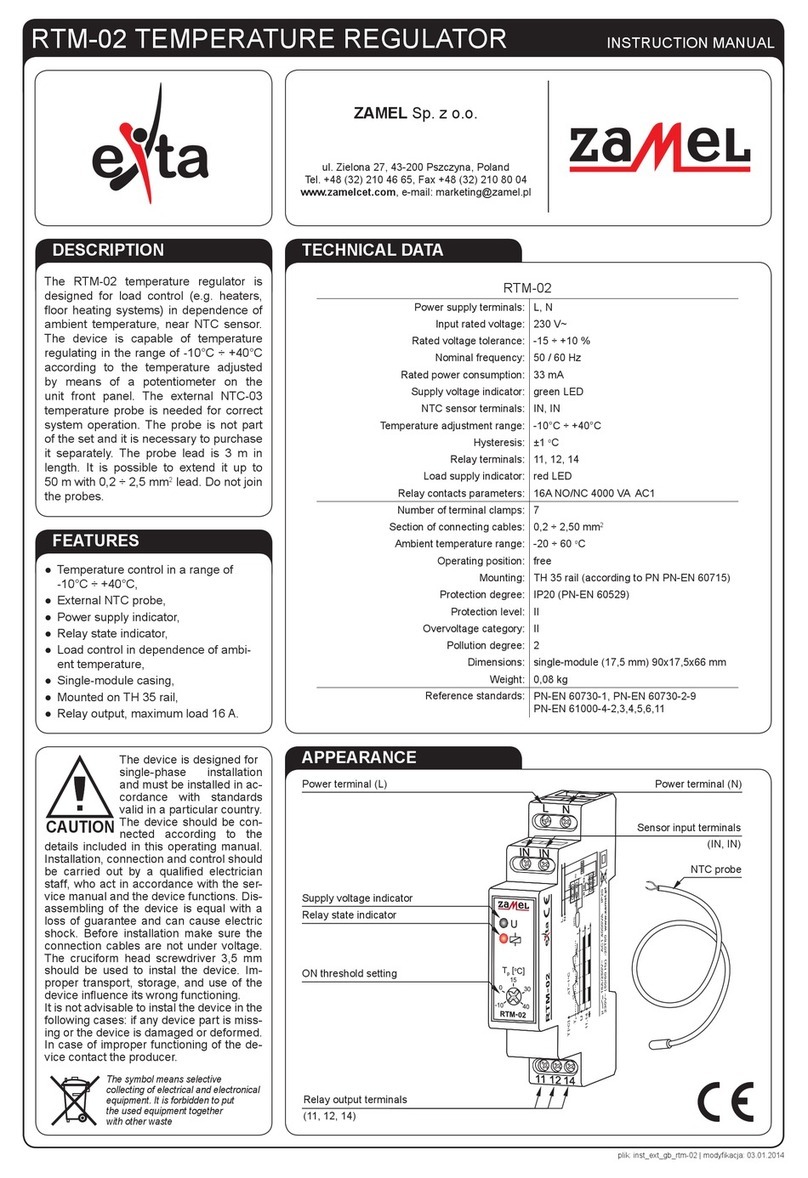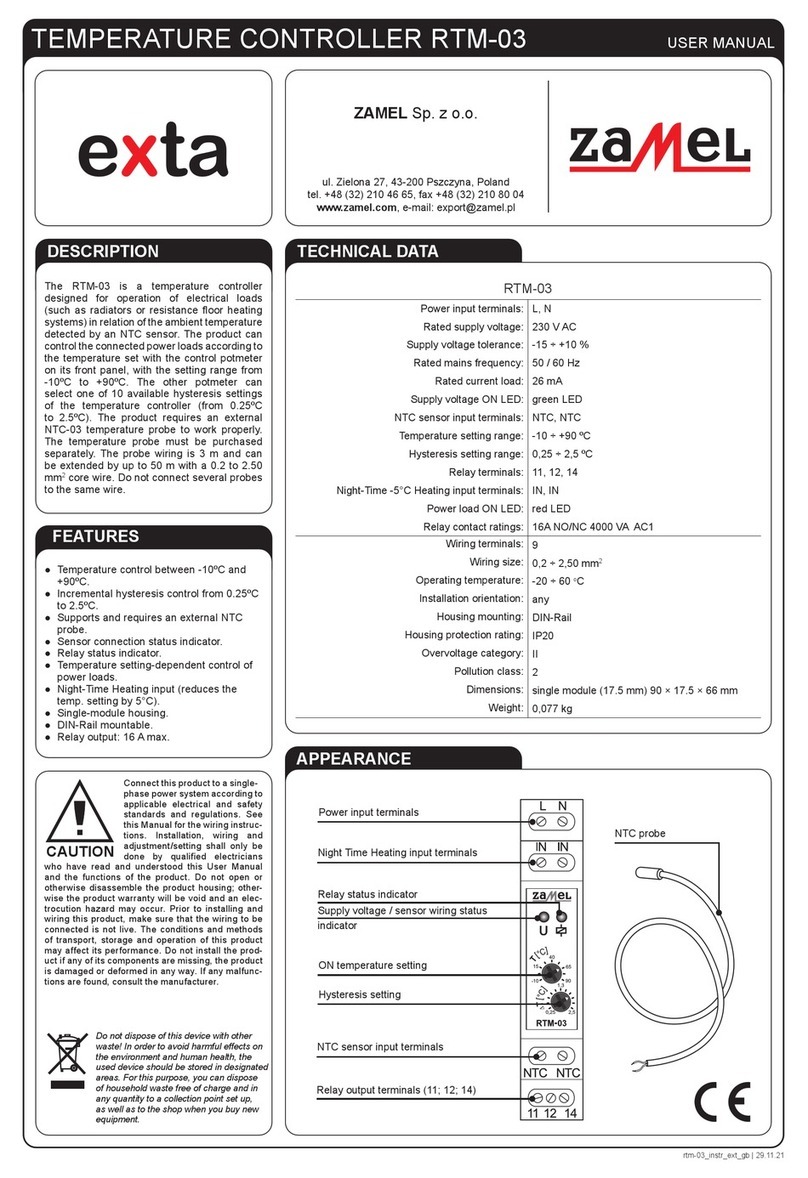
MATEC – ELECTRIC HEATING SYSTEMS
TEMPERATURE CONTROLLER RTS-02
MANUAL INSTRUCTION
ZAMEL Sp. z o.o.
ul. Zielona 27, 43-200 Pszczyna, Poland
tel. +48 32 449 15 00, +48 32 210 46 65, fax +48 (32) 210 80 04
OPERATION AND FUNCTIONALITY
6) A demand to display oor temperature.
In the operation mode where a room temperature sensor and a oor temperature limiter are used (position 8 of the conguration menu), pressing and hold-
ing the button for 3 seconds causes current oor temperature displayes. In case the sensor is not mounted or is damaged - Er symbol will be displayed.
7) Current day and time adjustment.
● Momentary pressing of the button causes the hour pulsates.
● Choose proper hour and AM / PM symbol by pressing and holding ▲ and ▼ buttons (AM shows time since midnight, AM shows time since noon).
● After choosing the hour press again the button. Minutes should pulsate.
● Choose proper minutes by pressing and holding ▲ and ▼ buttons.
● After choosing the minutes press again the button. The days of the week should pulsate.
● Choose a proper day by pressing and holding ▲ and ▼ buttons. Press once button. The display should show proper time and day. if no button is pressed
within 20 seconds the regulator switches to the operation mode according to the adjusted programme
8) Programme planning.
It is recommended to see the default settings of Times and temperatures in an exemplary schedule. If the programme is suitable press button so the regula-
tor starts operation according to the default settings. To change the adjusted times and temperatures follow the below description. Specify demanded times
and temperatures. Four time intervals must be programmed per one day. Temperature and starting time of the heating phase can be chosen independently.
(For example, following settings can be chosen: 05:00 AM and 21°C for the beginning of the rst heating time-interval for a workday, and also 07:00 AM and
16,5°C for the rst cooling time interval). It is recommended to write all time intervals and temperatures for all intervals in a table. A complete table enables
to save the user’s programme.
Heating schedule (programme default setting):
Time interval Days of the week (5 days) Saturday Sunday
Start time Temperature Start time Temperature Start time Temperature
Heating
6:00 AM 21 °C 6:00 AM 21 °C 6:00 AM 21 °C
8:00 AM 16,5 °C 8:00 AM 16,5 °C 8:00 AM 16,5 °C
5:00 PM 21 °C 5:00 PM 21 °C 5:00 PM 21 °C
10:00 PM 16,5 °C 10:00 PM 16,5 °C 10:00 PM 16,5 °C
9) Heating programme introduction
1. Press once button .„PRGM SETTING” command displays. Pulsating symbols of weekdays „Mon Tue Wed Thu Fri” will be shown on a display with
currently programmed start times for the rst heating time interval. The temperature for this interval will also be shown. The icon signals about
programming of the rst time interval (Get up).
2. Press button to adjust programmed time and temperature. Press button once (programmed temperature value will be displayed in a pulsating way).
Press ▲ and ▼ buttons to change the displayed temperature for the rst heating time interval.
3. Press button once (programmed time value will be displayed in a pulsating way). Press ▲ and ▼ buttons to adjust the demanded time. Time displayed
changes in a 15 minutes way. Press TIME button again after demanded time was chosen to return to the temperature change mode.
4. Press button once. The icon for the second time interval programming is displayed (Go out). The display also shows currently adjusted start time
and temperature for the second heating time interval.
5. Repeat steps 2 and 3 to adjust parameters for the second time interval of the programme.
6. Repeat steps from 2 to 5 for the third and fourth time intervals of the programme.
7. Press button once. „SA” symbol is displayed (programming for Saturday). The display also shows currently adjusted start time and temperature for
the rst heating time interval.
8. Repeat steps from 2 to 7 to insert programme data for Saturday.
9. Press button once to adjust Sunday („SU”) and repeat steps from 2 to 7 to insert programme data for Sunday.
10. Press button after inserting all data for the heating programme.
10) Return to the default settings.
Press button to enter the programming mode. Press simultaneously ▲ and ▼ buttons for 3 seconds. „DEF” symbol is displayed three times (it pulsates),
the programme returns to the setting phase. Press button so the regulator can start operation according to the default setting. In case no button is pressed
within 20 seconds the regulator returns to the operation mode compatible with the adjusted programme.
11) Control of the adjusted programme.
In order to check the adjusted programme settings before the programme starts, it is recommended to follow the below description. Press button to to
check the rst time interval data for a working day. Pressing button every time makes times and temperatures are displayed for the following time interval
(sequentially) for working days, and next for Saturday and Sunday (every time and temperature can be changed while reviewing). Press button so the
regulator can start operation according to the adjusted programme.
WARRANTY CARD
There is 24 months guarantee on the product
Salesman stamp and signature, date of sale
1. ZAMEL Sp. z o.o. assures 24 months guarantee for the product.
2. The manufacturer’s guarantee does not cover any of the following actions:
a) mechanical damage during transport, loading / unloading or under other circumstances,
b) damage caused by incorrect product mounting or misuse,
c) damage caused by unauthorised modications made by the PURCHASER or any third parties to the product or any other devices
needed for the product functioning,
d) damage caused by Act of God or any other incidents independent of the manufacturer - ZAMEL Sp z o.o.
e) power supply (batteries) to be equipped with a device in the moment of sale (if they appear);
3. The PURCHASER shall lay any claims in writing to the dealer or ZAMEL Sp. z o.o.
4. ZAMEL Sp. z o.o. is liable for processing any claim according to current Polish legislation.
5. ZAMEL Sp. z o.o. shall process the claim at its own discretion: product repair, replacement or money return.
6. The manufacturer’s guarantee is valid in the Republic of Poland.
7. The PURCHASER’s statutory rights in any applicable legislation whether against the retailer arising from the purchase contract or
otherwise are not affected by this warranty.
APPEARANCE
The device is designed for single-phase
installation and must be installed in ac-
cordance with standards valid in a par-
ticular country. The device should be
connected according to the details included in this
operating manual. Installation, connection and con-
trol should be carried out by a qualied electrician
staff, who act in accordance with the service manual
and the device functions.
In case of casing dismantling an electric shock may
occur, and the guarantee is lost then. Before instal-
lation make sure the connection cables are not un-
der voltage. The cruciform head screwdriver 2,5 mm
should be used to instal the device. Improper trans-
port, storage, and use of the device inuence its
wrong functioning. It is not advisable to instal the
device in the following cases: if any device part is
missing or the device is damaged or deformed. In
case of improper functioning of the device contact
the producer.
The symbol means selective
collecting of electrical and electronic
equipment. It is forbidden to put
the used equipment together with
other waste.
CAUTION!
FEATURES
TECHNICAL DATADESCRIPTION
• a big LCD display;
• the LCD display shows simultaneously the
adjusted temperature and the room tem-
perature;
• user’s settings and default settings are kept
in a non-volatile memory;
• temperature is displayed in: Celsius or
Fahrenheit (temperature) scales;
• 3 control modes - MODE A: - control by
means of a room sensor, MODE F: - con-
trol by means of a floor sensor, MODE AF:
- control by means of a room sensor with
floor temperature limitation;
• separate programming possibility for 5
weekdays and for a cycle of 1 day / 1 day
(Saturday/Sunday);
• programming with four separate time inter-
vals / temperature intervals during a day;
• calibration possibility of a displayed tem-
perature value;
• protection against freezing;
• pump protection.
RTS-02 temperature controller is a pro-
grammable regulator. It is used to heat oors
and to limit oor’s temperature. The device
cooperates with electric and water oor heat-
ing systems. RTS-02 is equipped with battery
supply backup (2 x AA battery).
RTS-02
Input (supply) terminals: L, N
Input rated voltage: 100 ÷ 240 V~
Nominal frequency: 50 / 60 Hz
Nominal power consumption: 0,40 W – STANDBY
Battery backup: Yes (2 x AA battery)
NTC senor terminals: RT2+, RT2-
Temperature sensor: NTC 100k dla 25 °C
Room temperature adjustment range: +5 ÷ +50 °C
Floor temperature control range: +5 ÷ +50 °C
Accuracy of temperature measurement: ±1 °C
Adjustment accuracy: ±0,5 °C
Output type: relay 16A dla 250 VAC
Number of terminal clamps: 7
Section of connecting cables: 0,5 ÷ 1,5 mm2
Ambient temperature range: -5 ÷ +50 °C
Casing mounting: surface
Casing protection degree: IP21
Protection level: II
Overvoltage category: II
Dimensions: 90 x 115 x 29 mm (height x width x depth)
Weight: 0,180 kg
Reference standard: ETSI EN301 489-1, ETSI EN301 489-3,
EN 60730-1:2000+A12:2003,
EN 60730-2-9:2002
1. Power supply button (Switch on / Switch off).
2 A bi-functional button to display the room temperature,
the oor temperature and time adjustments.
3 Default settings button.
4 Programme start conrmation button.
5 Reset button.
6 Maximum temperature adjustment button.
7 Minimum temperature adjustment button.
8. Current day or programmed days display. 9. Cur-
rent time or programmed time display. 10. Am: time in-
dication: morning and afternoon, Pm: time indication:
afternoon and evening, Days: number of days, Hours:
number of hours. 11. Temperature scales display: Cel-
sius (°C) or Fahrenheit (°F). 12. Temperature adjust-
ment range. 13. Temperature limit excess in AF mode
signalling.14. Regulator’s programming mode signal-
ling. 15. Pump protection mode signalling. 16. 16-A:
Signalling of the mode operation with a room tempera-
ture sensor, 16-F: Signalling of the mode operation
with a oor temperature sensor, 16-AF: Signalling of
the mode operation with a room temperature sensor
and a oor temperature limiter. 17. Heating switch
on signalling. 18. Standby symbol. 19. Time ranges:
the remaining time to wake up , the remaining time to leave , the remaining time to return , the remaining
time to go and rest . 20. Day / time adjustment: current time and day display. 21. Prog setting: Signalling of the
programme setting adjustment mode. 22. Cofg: Signalling of regulator’s conguration mode. 23. Signalling of the cur-
rent regulator’s operation mode. 24. Signalling of the holiday temperature mode. 25. Current room temperature display.
8 9 10 11 12
1617
15
14
13
23
24
25
1819202122
plik: inst_cet_en_rts-02 | modykacja: 20.04.2017






















